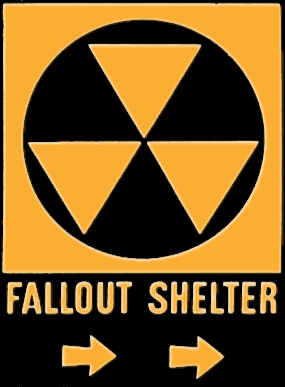Early Rocket History
Rockets have been around for hundreds of years. The Chinese used rockets as a battlefield weapon in 1232 CE. These rockets were described as "arrows of flying fire." The British fired rockets against Ft. McHenry in the War of 1812, inspiring Francis Scott Key to write "The Star Spangled Banner" with its lyrics about "The rockets' red glare."
Konstantin Tsiolkovsky
A Russian school teacher, Konstantin Tsiolkovsky, developed the basic theory of rocket propulsion. In 1903, he wrote an article called "The Exploration of Cosmic Space by Reactive Propulsion Apparatuses." He developed a design for a manned, tear-drop-shaped spacecraft in later writings. His design included garden plants to replenish oxygen. Liquid oxygen and liquid hydrogen propelled the spacecraft.
Robert Goddard
Robert Goddard (1882-1945) launched the world's first successful liquid-propelled rocket on March 16, 1926, in Massachusetts. The fuel was liquid oxygen and gasoline. The rocket reached an altitude of 41 feet. Goddard continue rocket experiments in Roswell, New Mexico.
During World War II, interest in rockets increased. Goddard developed A-series rockets, which had automatic gyroscope stabilizers in the rocket nose cone to provide directional control. The gyroscope was connected by shafts to a series of movable vanes in the path of the rocket's exhaust.
Goddard developed P-series rockets between 1938 and 1941, but died in 1945.
Wernher von Braun
German rocket scientist Wernher von Braun (1912–1977) designed V-2 rockets during World War II. Liquid oxygen and an ethyl alcohol-water mixture fueled the V-2. The first operational V-2 was fired against Paris on September 6, 1944.
J. Robert Oppenheimer
President Franklin D. Roosevelt (1882–1945), established the Manhattan project to develop nuclear weapons in 1941. Robert Oppenheimer became the project's director.
Robert Oppenheimer led a team of researchers in Los Alamos, New Mexico that developed the first atomic bomb. The bomb used supersonic shock waves produced by high explosives to crush or implode a ball of either plutonium or uranium to a supercritical state. A nuclear explosion was thus produced.
The first atomic bomb was tested on in the southern New Mexico desert on July 16, 1945. The test location was called Trinity Site.
Hiroshima & Nagasaki
The United States dropped an atomic bomb on Hiroshima, Japan on August 6, 1945.
Another atomic bomb was dropped on Nagasaki on August 9, 1945.
Japan surrendered on September 6, 1945.
The deployment of the atomic bomb created an "arms race" between the United States and the Soviet Union, which became known as the "Cold War."
World War II Aftermath
After the war, both the Soviet Union and the United States continued rocket development. Both had captured German engineers and rocket assets at the end of World War II. Wernher von Braun came to the United States to continue his work. Some of his V-2 rockets were tested at White Sands, New Mexico.
On August 29, 1949, the Soviet Union successfully tested its first atomic bomb.
The next challenge for each nation was to develop an Intercontinental Ballistic Missile (ICBM) which could deliver a nuclear weapon from that nation's soil to its respective enemy's cities and military bases.
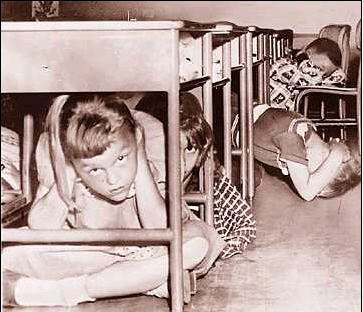
Wiston Churchill
Winston Churchill (1874-1965) was the prime minister of Great Britain during World War II.
He gave a speech on March 5, 1946, in Fulton, Missouri. He spoke of how "From Stettin in the Baltic to Trieste in the Adriatic, an iron curtain has descended across the (European) Continent."
His speech symbolized the beginning of an American and British understanding that the Cold War had begun.
1950s
Fearing a nuclear attack Americans build bombshelters and fallout shelters.
Suspenseful films such as "The Day the Earth Stood Still" warn of impending doom if the nations of the Earth continue developing nuclear weapons.
Meanwhile, the U.S. government produced a number of absurd propaganda films seeking to calm public fear about nuclear warfare.
A cartoon character, "Bert the Turtle," stressed the need to take cover from flying glass and other debris in case of a raid. He starred in an animated film that contained a lively jingle:
''There was a turtle by the name of Bert.
And Bert the Turtle was very alert.
When danger threatened him he never got hurt. He knew just what
to do.
He'd Duck and Cover. Duck and Cover.
He did what we all must learn to do. You and you and you and
you.
Duck and Cover!'' |
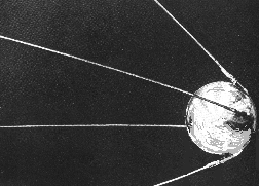 |
Sputnik 1 - The First Satellite - Launched October 4, 1957
|
Sputnik
During 1957 to 1958, the Soviet Union and the United States held an International Geophysics Year to promote the study and understanding of the Earth. The Soviets responded by launching the Sputnik 1 satellite on October 4, 1957. This was the first artificial satellite ever launched. The satellite, a steel sphere, weighed 184 pounds, was 23 inches in diameter. It sent out a "beep-beep" radio signal through its four antennas scientists and ham radio operators throughout the world could hear. The signal continued until the transmitter batteries ran out on October 26, 1957.
Sputnik also had instrumentation to measure the density of the atmosphere while it traveled in its elliptical orbit about the Earth with a perigee of 155 miles and an apogee of 559 miles. It orbited the Earth once every 96 minutes, and remained in orbit until January 4, 1958. It burned up as it re-entered the Earth's atmosphere.
Sputnik had been launched on an ICBM booster rocket called R-7 from Baikonur in Russia. Sergei Korolev led the team that developed it. They drew heavily upon German rocket technology used in World War II. The Sputnik launch was a spectacular propaganda victory for the Soviet Union and its leader Nikita Khrushchev.
Listen to sound files from the Sputnik radio signal:
 |
Laika
|
The Soviet Union went on to launch a series of Sputnik satellites. Sputnik 2 carried a dog named Laika into space.
President Dwight Eisenhower
Dwight Eisenhower (1890-1969), President of the United States, dismissed the Sputnik as being insignificant. Many Americans, however, considered it as a symbolic nuclear weapon.
President Eisenhower had to face the reality that the Soviet Union was winning the "space race."
In 1958, President Eisenhower spent a bill to Congress to create NASA, the National Aeronautics and Space Administration. Congress passed the bill.
Senator Lyndon Johnson played a key role in this effort. Johnson later became president, after President Kennedy died.
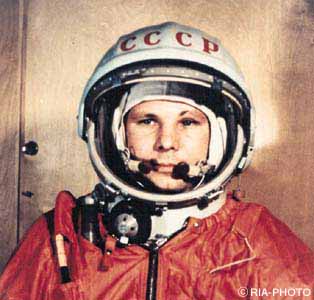 |
Cosmonaut Yuri A. Gagarin - first man to orbit the Earth
|
Yuri A. Gagarin
The first manned space rocket was the Soviet Vostok 1, which launched cosmonaut Yuri A. Gagarin.
Gagarin made a single orbit of the Earth on April 12, 1961. His flight lasted 1 hour and 48 minutes. The apogee was about 203 miles above sea level. The orbital speed was approximately 17,000 miles per hour. This was also a great propaganda victory for the Soviet Union.
President John F. Kennedy
John F. Kennedy was inaugurated as president of the United States in January 1961. He faced an early embarrassment over the Bay of Pigs fiasco in Cuba. Afterwards, he needed some tangible victory to deflect attention away from this fiasco and to also show America's superiority over the Soviet Union.
The Soviet Union and the United States were competing for the political allegiance of third-world countries.
On May 25, 1961, Kennedy gave a speech to congress:
"I believe that this nation should commit itself to achieving the goal, before this decade is out, of landing a man on the Moon and returning him safely to the Earth. No single space project...will be more exciting, or more impressive to mankind, or more important...and none will be so difficult or expensive to accomplish...."
Congress funded Kennedy's goal.
The arms race and the space race continued in parallel. President Kennedy faced the Cuban missile crisis in 1962. The Soviet Union finally agreed to remove its missiles from Cuba with the understanding that the United States would remove its missiles from Turkey.
Tragically, President Kennedy was assassinated November 22, 1963.
Alan B. Shepard & John Glenn
In response to Kennedy's challenge, America started to catch up with Soviet space rocketry.
Alan B. Shepard was the first American in space. Launched on top of a Redstone missile, he made a short, suborbital flight in a Mercury capsule on May 5, 1961.
John Glenn was the first American to orbit Earth. His flight was on February 20, 1962.
Further Soviet Union Achievements
Thereafter, the Soviets and the United States competed to be the first nation to launch two and then three astronauts at a time, and to be the first to perform a space walk and achieve other feats. This competition has been called the "space race." The Soviet Union won most of the early milestones. The Soviets launched the first woman into orbit; Cosmonaut Valentina Tereshkova flew on Vostok 6 on June 16-19, 1963. Cosmonaut Valeri Bykovsky had been launched on Vostok 5 two days before Tereshkova's launch. The two spacecraft came within three miles of each other.
Meanwhile, Wernher Von Braun led a team to develop the Saturn V booster to achieve Kennedy's goal. This booster was used to send the Apollo astronauts to the moon.
Astronaut and Cosmonaut Deaths
Both the Soviet Union and the United States suffered a number of setbacks along the way. The first Apollo mission, Apollo 1, was to be manned by Gus Grissom, Ed White, and Roger Chaffee, but all three died in a fire inside their command module during a pre-flight test at the launch pad on January 27, 1967. In addition, in 1967, Cosmonaut Komarov died as his Soyuz 1 spacecraft made a crash landing because of control problems and parachute lines becoming tangled.
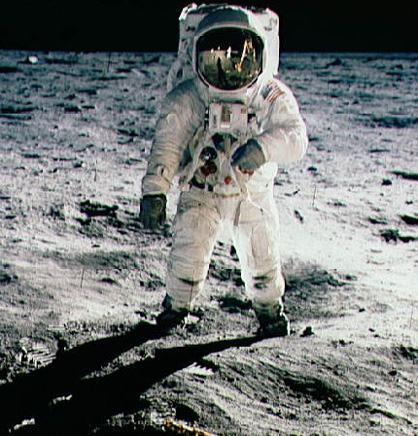 |
Astronaut Buzz Aldrin on the Moon. This
photo was taken by Neil Armstrong.
The reflection of Armstrong and the Lunar Module are visible
on Aldrin's visor.
|
Neil Armstrong and Buzz Aldrin Land on the Moon
The space programs of both nations recovered after these tragedies and resumed the race to the moon. America won this part; Neil Armstrong, then Buzz Aldrin, became the first two men to reach the moon on July 20, 1969. Meanwhile, Michael Collins orbited the moon in the Command Module. This mission was the Apollo 11 mission.
The U.S. thus won the Space Race. The Cold War, however, continued until the break-up of the Soviet Union, about twenty years later.
The purpose of sending astronauts to the Moon was to achieve a "political goal," namely proving to the world that the U.S. was superior to the Soviet Union. Science and engineering objectives were less important.
Soviet Lunokhod
The Soviets never put a man on the Moon, but they did send a number of unmanned, robot vehicles to the Moon. These robots were called Lunokhod as part of the Luna spacecraft series. The Lunokhod were actually roving vehicles, which could move around on the surface of the Moon. They also had television cameras and antennas to transmit pictures back to Earth. Three of these robotic probes collected lunar soil samples and returned them to Earth in 1970, 1972, and 1976.
America's Space Program after the Lunar Missions
After winning the race, however, American lost interest in the Moon, and Apollo 17 became the last lunar mission in December 1972. America's next space project was the Skylab space station. Three crews were sent to this space station, from 1973 to 1974. The Apollo-Soyuz rendezvous mission in July 1975 was a brief break in the Cold War; President Richard Nixon and Soviet Premier Leonid Brezhnev wanted to prove the United States and the Soviet Union could cooperate in space. The Soviet cosmonauts, Alexsei Leonov (who had been the first man to walk in space) and Valeri Kubasov docked their spacecraft with that of American astronauts, Tom Stafford, Vance Brand, and Deke Slayton.
During the remainder of the 1970's, Americans were preoccupied with Watergate, the Viet Nam War, the Arab oil embargo, the Bicentennial celebration, the Iranian Hostage crisis, and other issues. Americans thus lost interest in the space program.
The Saturn V booster, used for the Apollo program, was the most powerful booster ever built. After the Apollo-Soyuz mission, however, the tooling and fixtures for the Saturn V were scrapped. This effort was led, or at least encouraged, by parties who wanted a re-usable rocket with wings and wheels, namely the Space Shuttle. These parties felt that there was insufficient funding for both the Saturn V and the Space Shuttle to be in operation simultaneously.
Continuation of Cold War
President Nixon and Soviet Communist Party Secretary Leonid Brezhnev sign two basic SALT I documents in Moscow, on May 26, 1972:
1. An Interim Agreement limiting strategic offensive weapons.
2. The ABM Treaty, limiting strategic defensive systems.
President Nixon's Resignation
President Richard Nixon resigned on August 8, 1974. He said that he no longer had the support of congress after the "Watergate matter."
Books and Videos about the Space Race
The Right Stuff - This film is based on Tom Wolfe's book. It begin's with the story of the Chuck Yeager breaking the sound barrier. It then gives an historical drama about the Mercury space program.
The Dish - Historical drama-comedy about the town of Parkes in New South Wales, Australia. A 1,000-ton radio observatory dish is built in Parkes to relay telemetry, voice, and television signals from the historic Apollo 11 moon landing in July 1969.
Apollo 13 (Video/DVD) - Astronaut's Jim Lovell, Jack Swigert, and Fred Haise make an heroic return to Earth after an internal explosion cripples their Apollo 13 service module. -S tarring Tom Hanks. Directed by Ron Howard.
Lost Moon : The Perilous Voyage of Apollo 13 (Book) - By Jim Lovell and Jeffery Kluger
October Sky - Homer H. Hickam Jr. and his friends build and launch models rockets in a West Virginia coal mining town in response to the launch of Sputnik. Based on a true story.
|
Books and Videos about the Cold War
Atomic Cafe - Director Jayne Loader used government film clips in an expose of the madness and propaganda of the "Duck and Cover" era.
Thirteen Days - Historical drama about President's Kennedy's response to the Cuban missile crisis - Starring Kevin Costner.
Dr. Strangelove, or How I Learned to Stop Worrying and Love the Bomb - Arguably the greatest black comedy ever made, Stanley Kubrick's cold war classic is the ultimate satire of the nuclear age. - Starring Peter Sellers, George C. Scott, and Slim Pickins. Peter Sellers excels in three fine roles--as the Nazi braintrust Dr. Strangelove, as President Merkin Muffley, and RAF officer Lionel Mandrake.
The Russians are Coming - Popular comedy about a Russian submarine that lands off New England coast. Starring Alan Arkin, Eva Marie Saint, Carl Reiner, Brian Keith, and Jonathan Winters.
The Manchurian Candidate - Suspenseful political thriller about a Korean war hero's decoration and his mother's machinations to promote her Joseph McCarthy-like husband's career. Starring Angela Lansbury, and Frank Sinatra.
The Iron Giant - As Sputnik orbits the Earth, Hogarth, a young boy who lives in the Maine woods during the cold war, befriends a giant robot.
WarGames - Teenage computer whiz hacks into a computer system looking for games. He inadvertently causes the system to begin countdown for thermonuclear missile strikes against the Soviet Union. Starring Matthew Broderick.
The Day the Earth Stood Still - A flying saucer lands at Washington D.C.An alien named Klaatu and his robot Gort emerge from the saucer. Klaatu warns the people that the Earth will be destroyed if they continue nuclear warfare. The film is very suspenseful. Some critics regard it as the greatest science fiction film ever made despite its lack of special effects.
|
| |
|
